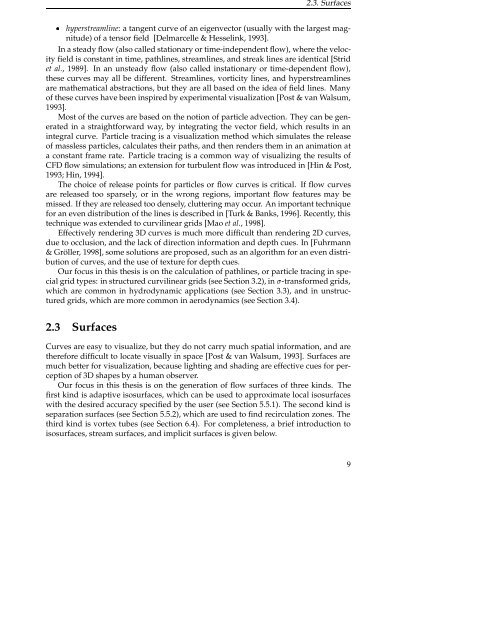Chapter 4 Vortex detection - Computer Graphics and Visualization
Chapter 4 Vortex detection - Computer Graphics and Visualization
Chapter 4 Vortex detection - Computer Graphics and Visualization
Create successful ePaper yourself
Turn your PDF publications into a flip-book with our unique Google optimized e-Paper software.
2.3. Surfaces<br />
¯ hyperstreamline: a tangent curve of an eigenvector (usually with the largest magnitude)<br />
of a tensor field [Delmarcelle & Hesselink, 1993].<br />
In a steady flow (also called stationary or time-independent flow), where the velocity<br />
field is constant in time, pathlines, streamlines, <strong>and</strong> streak lines are identical [Strid<br />
et al., 1989]. In an unsteady flow (also called instationary or time-dependent flow),<br />
these curves may all be different. Streamlines, vorticity lines, <strong>and</strong> hyperstreamlines<br />
are mathematical abstractions, but they are all based on the idea of field lines. Many<br />
of these curves have been inspired by experimental visualization [Post & van Walsum,<br />
1993].<br />
Most of the curves are based on the notion of particle advection. They can be generated<br />
in a straightforward way, by integrating the vector field, which results in an<br />
integral curve. Particle tracing is a visualization method which simulates the release<br />
of massless particles, calculates their paths, <strong>and</strong> then renders them in an animation at<br />
a constant frame rate. Particle tracing is a common way of visualizing the results of<br />
CFD flow simulations; an extension for turbulent flow was introduced in [Hin & Post,<br />
1993; Hin, 1994].<br />
The choice of release points for particles or flow curves is critical. If flow curves<br />
are released too sparsely, or in the wrong regions, important flow features may be<br />
missed. If they are released too densely, cluttering may occur. An important technique<br />
for an even distribution of the lines is described in [Turk & Banks, 1996]. Recently, this<br />
technique was extended to curvilinear grids [Mao et al., 1998].<br />
Effectively rendering 3D curves is much more difficult than rendering 2D curves,<br />
due to occlusion, <strong>and</strong> the lack of direction information <strong>and</strong> depth cues. In [Fuhrmann<br />
&Gröller, 1998], some solutions are proposed, such as an algorithm for an even distribution<br />
of curves, <strong>and</strong> the use of texture for depth cues.<br />
Our focus in this thesis is on the calculation of pathlines, or particle tracing in special<br />
grid types: in structured curvilinear grids (see Section 3.2), in -transformed grids,<br />
which are common in hydrodynamic applications (see Section 3.3), <strong>and</strong> in unstructured<br />
grids, which are more common in aerodynamics (see Section 3.4).<br />
2.3 Surfaces<br />
Curves are easy to visualize, but they do not carry much spatial information, <strong>and</strong> are<br />
therefore difficult to locate visually in space [Post & van Walsum, 1993]. Surfaces are<br />
much better for visualization, because lighting <strong>and</strong> shading are effective cues for perception<br />
of 3D shapes by a human observer.<br />
Our focus in this thesis is on the generation of flow surfaces of three kinds. The<br />
first kind is adaptive isosurfaces, which can be used to approximate local isosurfaces<br />
with the desired accuracy specified by the user (see Section 5.5.1). The second kind is<br />
separation surfaces (see Section 5.5.2), which are used to find recirculation zones. The<br />
third kind is vortex tubes (see Section 6.4). For completeness, a brief introduction to<br />
isosurfaces, stream surfaces, <strong>and</strong> implicit surfaces is given below.<br />
9

















